Sweating through the heat wave in California’s hottest county
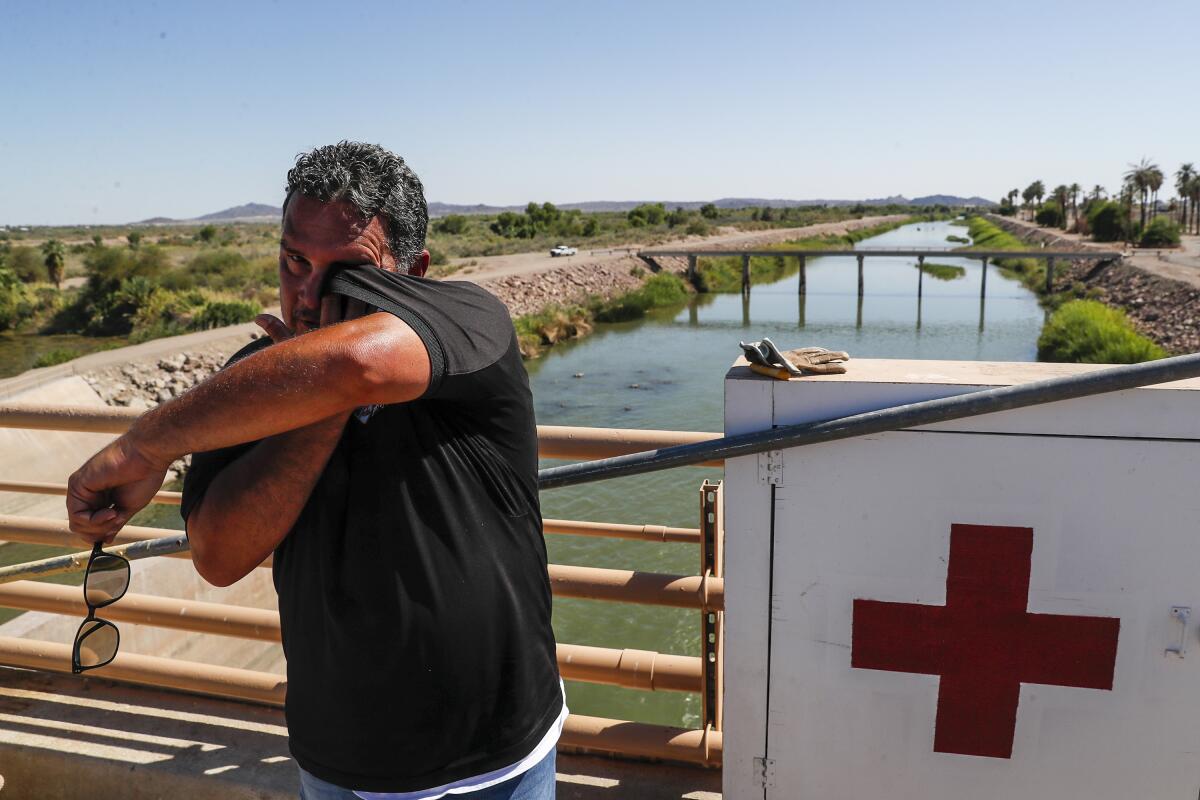
This is the Sept. 8, 2022, edition of Boiling Point, a weekly newsletter about climate change and the environment in California and the American West. Sign up here to get it in your inbox.
It was just before 9 a.m. and already nearing 100 degrees as I stared out at the menacing steel pillars of the U.S.-Mexico border wall, in California’s far southeastern corner. My long-sleeve shirt stuck to my skin. Sweat dripped down my back.
The record-smashing heat that would threaten rolling blackouts across much of California was still days away. But triple-digit temperatures are par for the course in the Sonoran Desert enclave of Imperial County, population 180,000.
So far this year, Imperial’s average high temperature is more than 6 degrees warmer than any other California county, federal data show. Over the last five years, it’s gotten less than half as much rain than the next-driest county, on average.
I was visiting the Imperial Valley with an L.A. Times reporting team to tell a story about solar energy — Part 2 of our Repowering the West series. But as John Muir once said, “When we try to pick out anything by itself, we find it hitched to everything else in the universe.” So a story about energy had also become a story about water, agriculture and local politics — and the crucial role the Imperial Valley could play in helping California navigate a future of crushing heat waves, droughts and wildfires.
To understand why, consider this: Between me and the border wall was a sparkling canal brimming with Colorado River water.
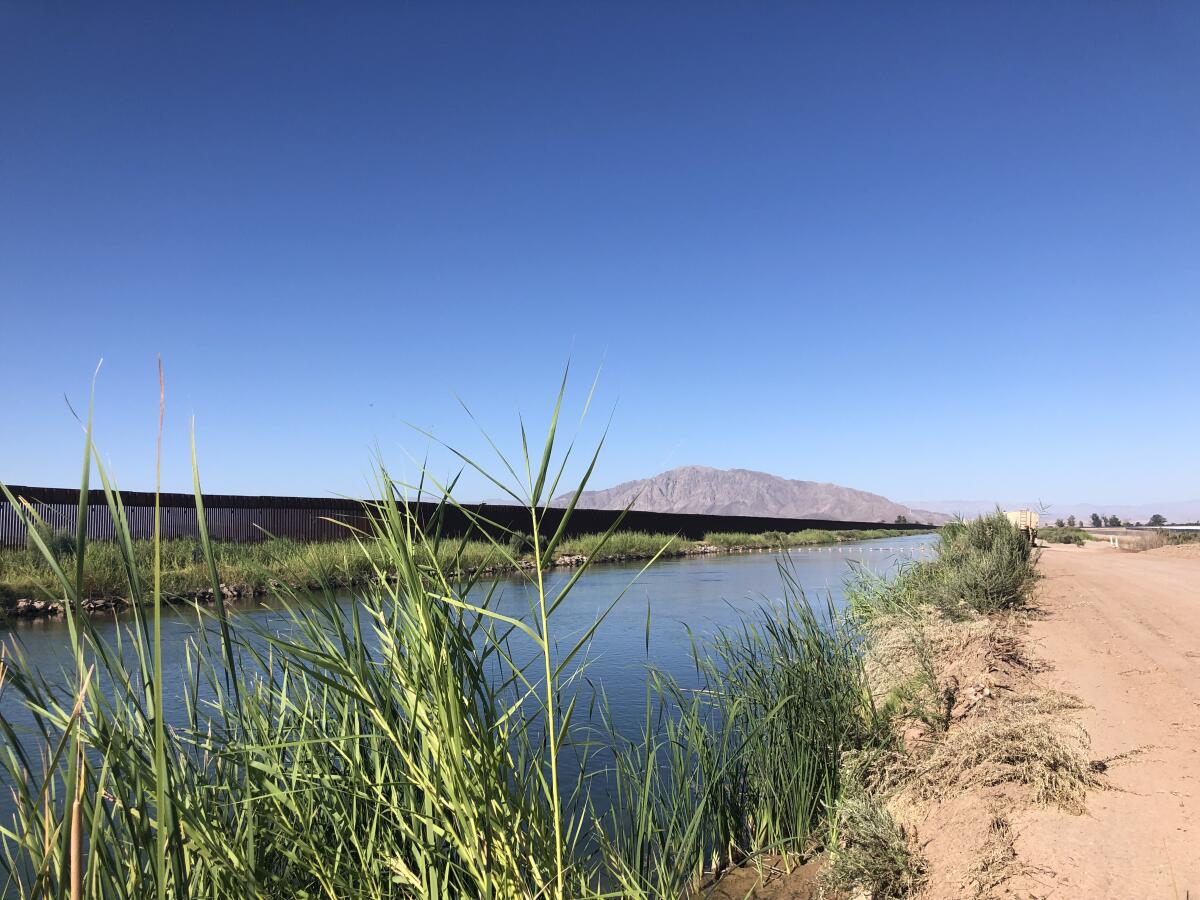
And surreal as it felt to watch all that water rush through the desert, the view to the north may have been even stranger. Nearly half a million acres of lush green farm fields stretched into the distance, irrigated by the dwindling Colorado.
“I don’t fault people when they say, ‘Why are you farming in the desert?’” said local grower Trevor Tagg, my tour guide that day. “But once you get down here ... you realize this valley you’re in right here is the most productive farm ground on Earth.
“Without this valley,” he added, “I can’t imagine what our grocery stores would look like.”

It’s also hard to imagine what California will look like next year or the year after — let alone in 2030, or at midcentury.
Already, people are struggling to survive the heat as they go about their daily lives. Already, firefighters are collapsing on the job because it’s so damn hot. Already, Lake Mead and Lake Powell — the American West’s largest reservoirs — are on the edge of “dead pool” as a long-term drying trend shrinks the snowpack that feeds the Colorado River and its tributaries.
And already, California is having trouble keeping the lights on as rising temperatures drive up air conditioning use. That’s what happened Tuesday, when the state narrowly avoided power shortages after setting a new record for electricity demand. Officials reported peak demand of 52,061 megawatts on the state’s main power grid — nearly 1,800 megawatts above the old mark.
Reliable power has become a recurring challenge for California, especially on hot summer evenings when solar panels stop producing but temperatures remain high. In August 2020, the state suffered its first rolling blackouts in nearly two decades. The following summer, more rotating outages were barely averted after a wildfire knocked out several key power lines.
Keeping the lights on is a political priority for Gov. Gavin Newsom, who doesn’t want to see Californians plunged into darkness on his watch — especially as rumors swirl that he’s mulling a run for president. He’s been busy issuing emergency declarations and executive orders to secure additional energy supplies — including polluting gas plants and diesel backup generators.
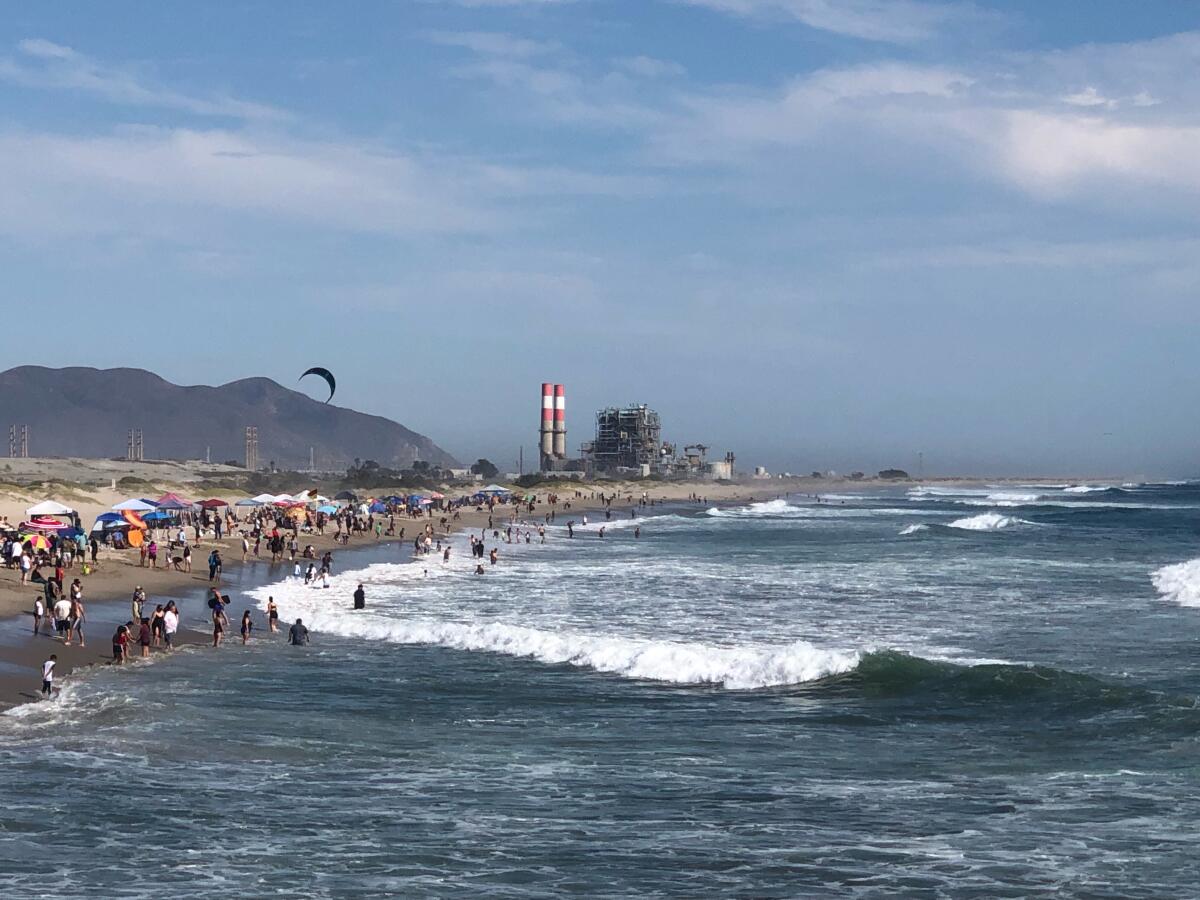
Newsom’s staff has also been “dialing for megawatts,” urging industrial and commercial energy users to cut back consumption during high-stress hours. That’s on top of the Flex Alerts the California Independent System Operator has issued every day for more than a week now, asking all of us to use less electricity — while staying safe — during the crucial hours of 4-9 p.m.
If you got an emergency alert on your phone Tuesday evening begging you to save power, that may have been the key to staving off outages — especially now that Flex Alerts are issued so frequently many people have stopped taking them seriously.
State officials say the emergency alert was followed by a rapid drop in energy demand, right at the crucial moment. But they also know they can’t rely on such notifications too often, or they’ll lose their effectiveness, too.
“We spent the last four to five days debating the merits” of an emergency alert, Newsom told reporters Wednesday outside the Beverly Hilton hotel, where he was attending a conference. “It was a decision that we needed to make in order to test the theory that this could be a game-changer. And it turns out it was.”

Those are some of the problems California faces. The Imperial Valley offers possible solutions.
The valley’s north end is home to one of the world’s strongest natural geothermal hot spots — an underground heat pocket that can be used to produce climate-friendly electricity 24 hours a day, unlike solar panels or wind turbines. There are already nearly a dozen geothermal power plants in the area, near the receding shoreline of the Salton Sea. More are planned.
The superheated underground fluid being tapped by geothermal energy companies also contains lithium — a crucial ingredient in electric vehicle batteries. It’s a resource that could help us ditch gas cars and stop fueling the climate crisis.
As the sun set over the Imperial Valley last week, I stood in the shadow of two geothermal/lithium test wells drilled by Controlled Thermal Resources. And when I say “in the shadow,” I don’t mean it literally. There was nothing to block the punishing sunlight as I chatted with Jim Turner, the company’s chief operating officer. He kept wiping sweat from his eyes.

It was just before 6 p.m. and still 108 degrees.
“Having been around here as long as I have — and having either run or built all the [geothermal] plants out here — I knew these wells were going to perform,” Turner said. “What I didn’t know was just how well they were going to perform.”
The Imperial Valley’s south end, meanwhile, is home to a cluster of sprawling solar farms, some of them right up against the border wall. They were built out over the last decade, and they’re not much help keeping the lights on after sundown.
But Imperial’s got a lot more sunlight left to give — and most of the solar farms being planned there today include lithium-ion battery storage systems that can bank clean power for the evening, when the electric grid is most stressed.
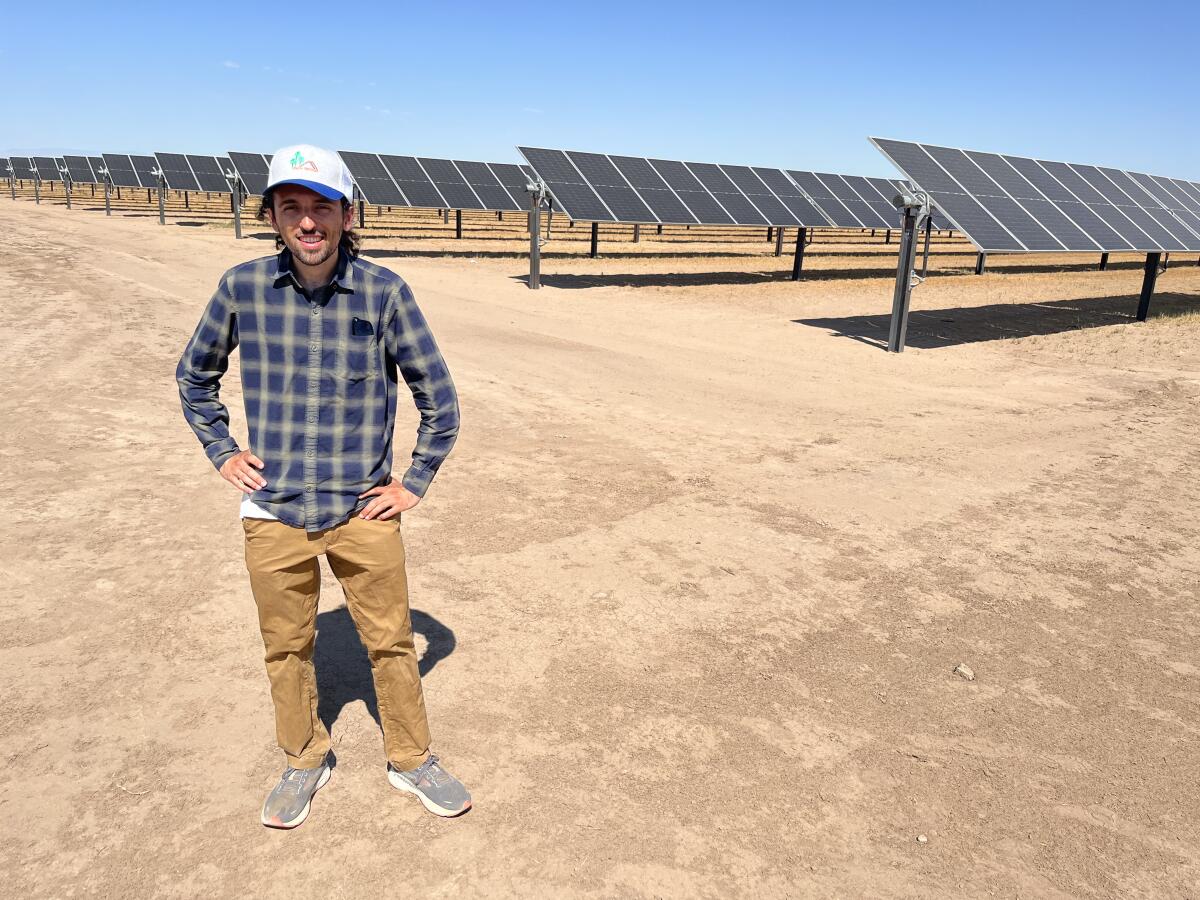
I could only imagine what one of those solar-plus-storage operations would look like as I stared across barren farmground on the valley’s eastern end. It was the hottest part of the day on the hottest day of our trip — 113 degrees at 5 p.m. — but Ralph Strahm didn’t seem to mind. He owned this land, and he was happy to explain why he’d agreed to sell it to a solar developer.
“We were spending a lot of money to farm it, and it just wasn’t suited to the crops that we were growing,” he said.
Therein lies the Imperial Valley’s other possible climate solution: water savings. Imperial uses far more Colorado River water than any other city or farming region in the West. By blanketing some of that farmland with solar and batteries — and storing more water in Lake Mead — California can help stem the climate crisis while also buying itself some insurance against drought.
That’s the vision pitched by clean energy advocates, anyway. I spent much of my time in Imperial talking with farmers who say cutting back on agriculture would be a disaster for the region. Look out for the story as part of Repowering the West.

Whatever role Imperial ends up playing, the clean energy transition is definitely underway.
It’s been remarkable, for instance, to see how far battery storage has come the last few years. At their peak on Monday, batteries added 3,300 megawatts of power to the state’s main electric grid — 1,000 megawatts more than the Diablo Canyon nuclear plant’s entire capacity. Just two years ago, there were only about 250 megawatts of storage installed overall.
But even as more batteries are added to the grid, they’re not a one-size-fits-all solution for reliable power — hence the need for other clean energy sources. That explains why Newsom urged the state Legislature to let Diablo Canyon stay open an additional five years, beyond its planned 2025 closing date — and why lawmakers heeded his call in an overwhelming vote last week.
I was asleep when lawmakers took that late-night vote, in hopes of being well-rested for a 6:30 a.m. start to try to beat the Imperial Valley heat — and ideally keep our photo and video crew’s cameras from melting. But it was convenient for Newsom that his controversial plan to rescue Diablo — which critics see as an enormous earthquake risk — came to a vote during one of the hottest weeks of the year. The governor’s timing was either very lucky or smart. Fear of blackouts is a powerful motivator.

It’s important to understand that heat waves are not only worsened by climate change — they also make it harder to meet our climate goals.
Partly that’s because studies show the best way to slash climate pollution is to electrify as many machines and appliances as possible — cars, heaters, stoves, etc. But if electricity supplies aren’t reliable, nobody will buy all that stuff. If you saw right-wing pundits making fun of California this week for asking people to limit when they charge their electric cars — right after the state enacted a plan to ban the sale of most new gas cars — well, they’re pointing out a serious problem that needs to be solved.
The other half of the heat wave-climate equation is that we’re currently relying on natural gas, a planet-warming fossil fuel, to keep the lights on after sundown. Gas plants are no panacea — several experienced partial outages this week, including two along the Southern California coast — but the fuel has supplied more than half of the state’s power during critical hours this week.
I got an up-close view of the gas fleet in Imperial, stopping with photographer Rob Gauthier to take nighttime photos outside the Imperial Irrigation District’s hulking gas plant in El Centro. Its lights cast an eerie glow against the sunset.
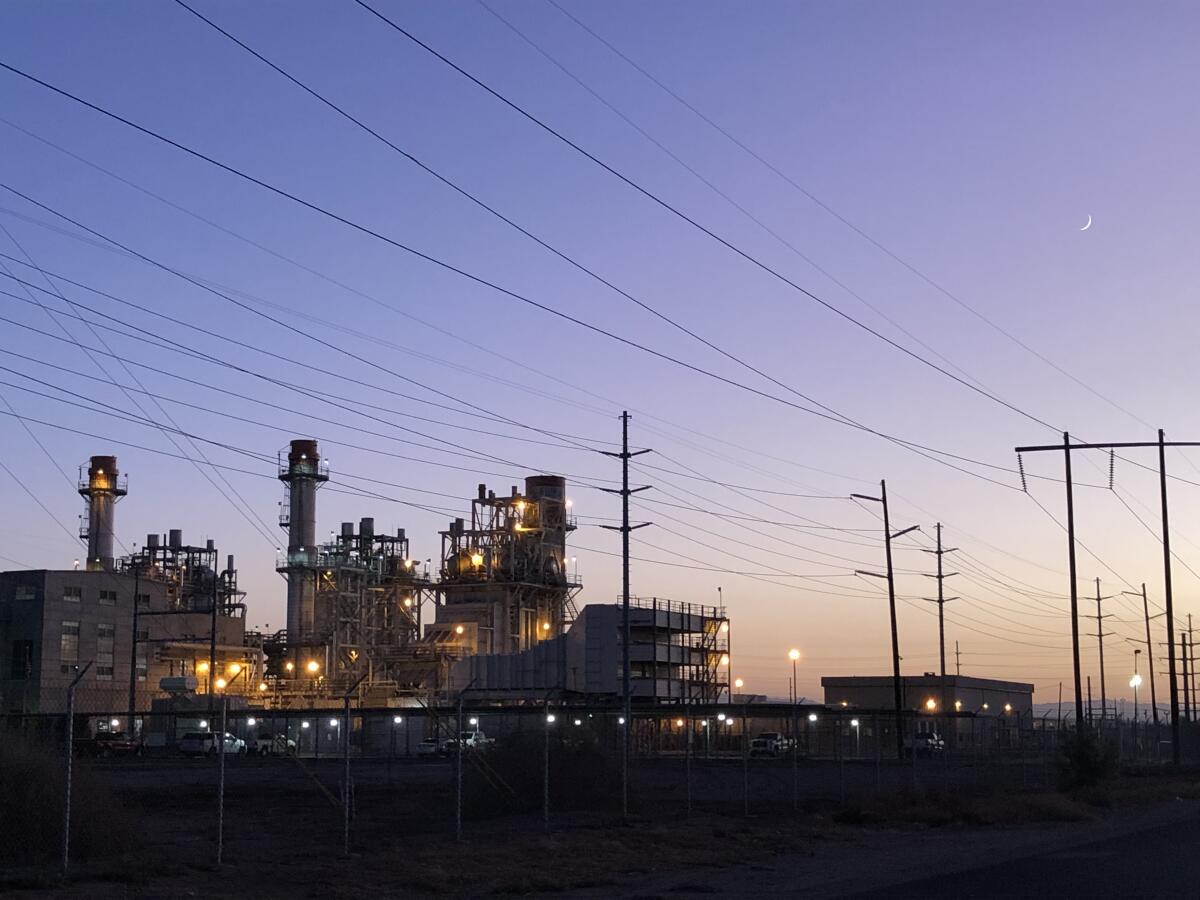
When I asked Newsom on Wednesday about breaking the state’s continued reliance on fossil gas, he emphasized the work his administration is doing to get more clean energy facilities built faster — work that’s arguably several years overdue.
“We all want to accelerate the elimination of the gas, but it’s a sober reminder of reality,” he said.
I also reminded Newsom that two years ago, he said California can’t wait until 2045 — the date currently mandated by law — to achieve 100% clean energy. When I asked if he still feels that way — and if so, what he’s doing about it — he pointed to the climate bills he pushed through the Legislature last week. Although the 2045 target date didn’t change, lawmakers set more aggressive interim goals of 90% clean energy by 2035 and 95% by 2040. They also approved tens of billions of dollars in climate spending.
“We pushed as far as we could, and we broke through,” Newsom said. “And you think we’re done? Quite the contrary.”
It’s not just California grappling with the new climate reality. Utilities in Nevada, Arizona, Utah and Idaho have also urged residents to save energy in recent days, with Salt Lake City breaking its September temperature record. Elliot Mainzer, president of the California Independent System Operator, said the Western electric grid as a whole saw record demand of 165 gigawatts Tuesday.
And the short-term crisis isn’t over yet. As I wrote this newsletter Wednesday afternoon, the California grid operator was once again warning about possible blackouts after sundown, and urging homes and businesses to minimize electricity use.
There are no easy answers, but that doesn’t mean the future is hopeless. We can all do our part to demand solutions.
But maybe worry about that tomorrow. For now, drink plenty of water, and stay out of the sun if you can. Here are some tips on how to keep cool, and and also how to save power. Don’t hesitate to blast the A/C if that’s what you need to stay safe.
And now, here’s what else is happening around the West:
THE HEAT, IT IS BAD

Some of us are privileged to work in air-conditioned offices — but others are packing 15 bottles of water to stay hydrated, burning their hands on asphalt, or collapsing in exhaustion when they finally get home. This gut punch of a story by my L.A. Times business desk colleagues — Suhauna Hussain, Kiera Feldman, Hugo Martín and Samantha Masunaga — chronicle the lives of a garment worker, a beekeeper, a delivery driver and others as they navigate the dangerous heat. Kids are at risk too, thanks to asphalt schoolyards that can hit 145 degrees in the San Fernando Valley, Alejandra Reyes-Velarde reports. L.A. now has a chief heat officer, Marta Segura, charged with protecting Angelenos. But as The Times’ Grace Toohey and Alexandra Petri report, she’s got a staff of just two, and a budget of just $1 million — not much in the grand scheme of things.
“No farmworker, no worker, no human being should be expected to work under these conditions.” So says Sen. Alex Padilla (D-Calif.), who has proposed federal legislation that would establish a standard to protect workers from hazardous heat, including access to water and paid breaks in cool spaces. Details here from my colleague Summer Lin. Unhoused people are also especially vulnerable; here’s what you can do to help them survive the heat, courtesy of Madalyn Amato. And lest this point get lost, we all need to take care of ourselves — especially at night, when rising temperatures are especially dangerous because our bodies don’t have a chance to cool down, as Sarah Trent writes for High Country News. So while Sacramento hitting a record-high 116 degrees made headlines, I was more concerned by the city tying its all-time high for an overnight low, at 77 degrees.
Because deadly heat isn’t bad enough, Californians are dying in wildfires, too. In the small city of Weed, in Siskiyou County, a historically Black neighborhood was wiped out with frightening speed by the Mill fire, The Times’ Alex Wigglesworth and Julia Wick report. Two people were found dead. Part of the problem is that the landscape is primed to burn by drought and heat, and flames are moving so fast they’re overtaking people preparing to evacuate, Hayley Smith and Jonah Valdez write. In Riverside County, the Fairview fire near Hemet has also killed two people — and although it’s not yet clear how the blaze started, Southern California Edison reported “circuit activity” about the same time the flames were first spotted. North of Los Angeles, meanwhile, seven firefighters were hospitalized with heat-related illness as they battled the Route fire.
WATER IN THE WEST
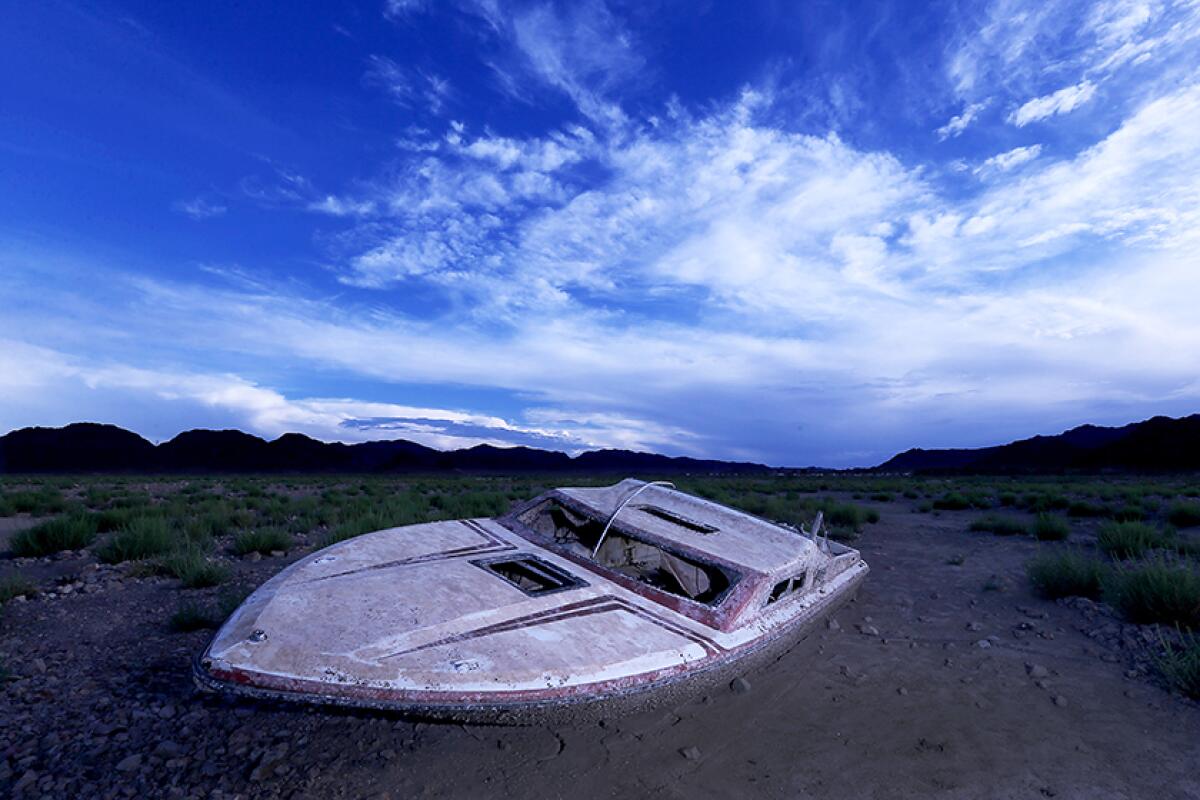
Federal officials are threatening to redefine “beneficial use” of Colorado River water, to try to compel agricultural agencies such as the Imperial Irrigation District to agree on voluntary cuts. That’s one key takeaway from this story by my colleague Ian James on the state of play on the Colorado. Not helping the situation: a leaky pipeline that’s led to a 15-day outdoor watering ban now in effect for millions of Southern Californians. In one more piece of Colorado River Basin news, a company that wants to pump groundwater in the Mojave Desert — and sell it to coastal cities — has agreed to provide free water to support restoration of the ailing Salton Sea in the Imperial Valley. Critics call the move by Cadiz Inc. a publicity stunt meant to drum up support for a fundamentally unsustainable water venture, as the Desert Sun’s Erin Rode reports.
“The browner your skin, the browner your water will be.” In the Central Valley, drought doesn’t just mean letting your lawn go brown — it can mean even higher likelihood of your well running dry, or pulling up contaminated water. Reporter Hayley Smith and photographer Brian van der Brug documented how low-income people of color in farm country are bearing the brunt of the drought, with far too little government support. And although there’s no comparison between the pain being felt by those families and by big farmers, it’s worth noting that U.S. crop yields could be down as much as one-third this year due to water shortages, according to the American Farm Bureau Federation. Here’s the story from the Washington Post’s Laura Reiley.
Europe is drying up like the American West, sending crop production spiraling and leaving rivers too low for boats to navigate. If that sounds bad ... well, it is. Check out the story by my colleagues Jaweed Kaleem and Scott Johnson, part of The Times’ Global California project.
POLITICAL CLIMATE
California lawmakers passed bills banning new oil and gas wells within 3,200 feet of homes and schools, requiring 90% clean energy by 2035 and targeting a carbon-neutral economy by 2045. Details here from Taryn Luna. While the Legislature approved most of Gov. Gavin Newsom’s climate proposals, it rejected a measure requiring the state to cut carbon pollution 55% below 1990 levels by 2030. According to Times columnist George Skelton, that measure may have been sabotaged by lawmakers unhappy with Newsom jamming through his climate package at the last minute. Skelton also wrote about how Newsom’s climate push — and his newfound support for nuclear power — may figure into his national political ambitions.
Lawmakers also sent Newsom a bill that would require oil refiners to open their books, in hopes of determining the cause of a “mystery surcharge” that has made gasoline more expensive than it should be. Here’s the story from Rob Nikolewski at the San Diego Union-Tribune. In one last bit of Sacramento news, The Times’ Susanne Rust reports that the Legislature passed a bunch more bills to clean up the waste stream. One of the bills discourages solid waste incineration, which pollutes disadvantaged communities already burdened with far too many hazards. Another makes it easier to have your body composted.
Angelenos will get to vote on a ballot measure that would require the city to add far more bike lanes and bus routes — and allow residents to sue if officials don’t follow through. The initiative will be on the 2024 ballot, my colleagues Rachel Uranga and David Zahniser report, and could make it easier to get around the city without a car. This November, meanwhile, several City Council seats and other local offices will be up for grabs — and if you care about climate change, Jane Fonda has some suggestions for you. The actor and activist’s climate PAC — political action committee — endorsed several candidates, according to the latest edition of L.A. on the Record, our local politics newsletter.
THE ENERGY TRANSITION
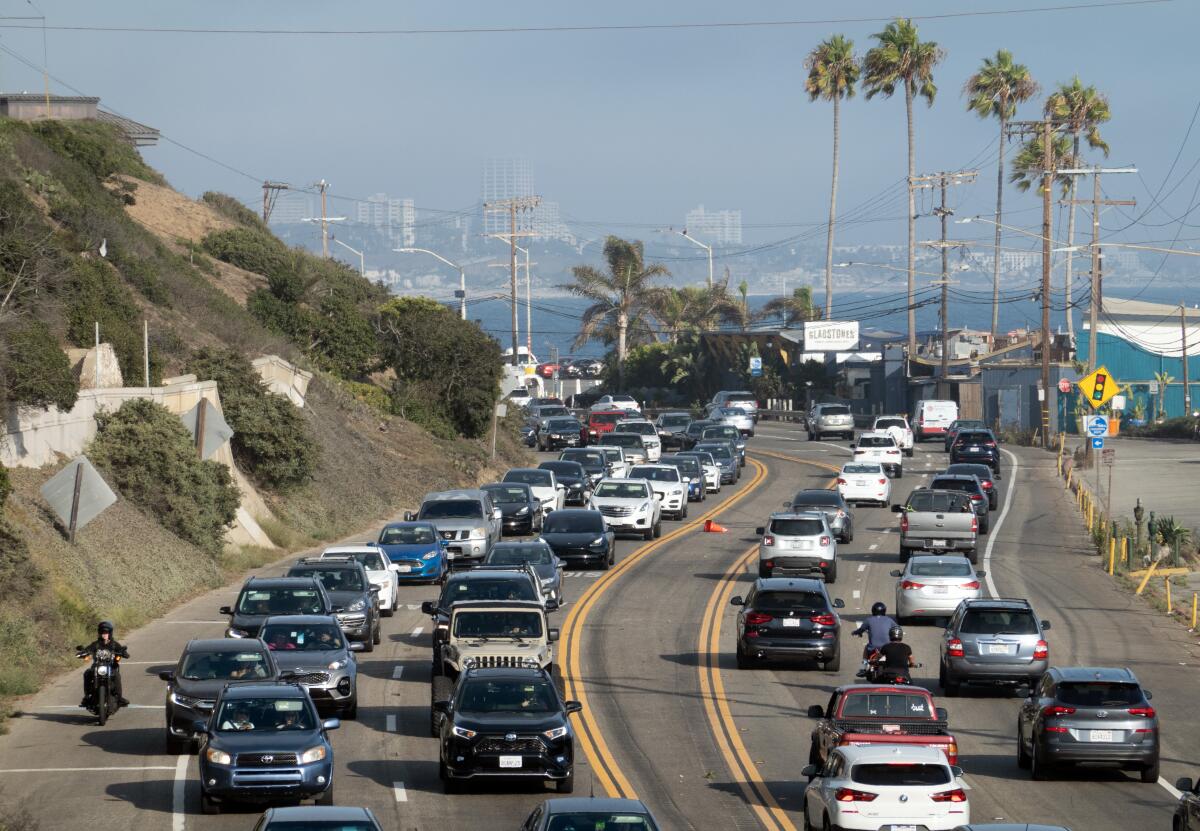
Can California deliver on its goal of ending the sale of most gasoline vehicles by 2035? Hayley Smith and Tony Briscoe take a look at the success (or failure) of the state’s past climate initiatives, and what we can learn from them. If California succeeds, there should be a positive ripple effect, with nearly one-third of all U.S. states poised to follow its lead on the electric vehicle rule, as Zach Bright reports for Bloomberg Law. One possible shortcoming of California’s approach: It’s encouraging car companies to help low-income families afford electric cars but not actually requiring them to, per Kathleen Ronayne at the Associated Press.
Meet the energy historian who says rapid decarbonization is a fantasy. I’m guessing some of you will object to the premise of my colleague Russ Mitchell’s interview with Vaclav Smil, which is that we’ll never phase out fossil fuels as quickly as scientists say is necessary. Personally, I’ve got several objections, which I shared on Twitter. But Smil makes some good points about our collective failure to grapple with reality. For instance: “So far, we are not even seriously trying — see the ascent of SUVs, the pervasiveness of excessive flying, and food supermarkets that now average 40,000 items. That all requires plenty of carbon.”
“Green energy is glamorous. Basic safety is not.” That’s Russ Mitchell again, summarizing a key finding of Wall Street Journal reporter Katherine Blunt’s new book, “California Burning.” Blunt explored why Pacific Gas & Electric — and its government overseers — failed for decades to promote wildfire safety. Read the review here, and an adapted excerpt from the book here. The propensity of big utility companies to spark deadly fires is one reason why some clean energy advocates prefer rooftop solar power, which doesn’t require long-distance electric lines. That’s what came to mind when I read about rooftop solar firm Sunnova’s proposal to build microgrids to power new neighborhoods, without any involvement from the big utilities. Details here from Ivan Penn at the New York Times. It’s yet to be seen whether the California Public Utilities Commission approves.
ONE MORE THING
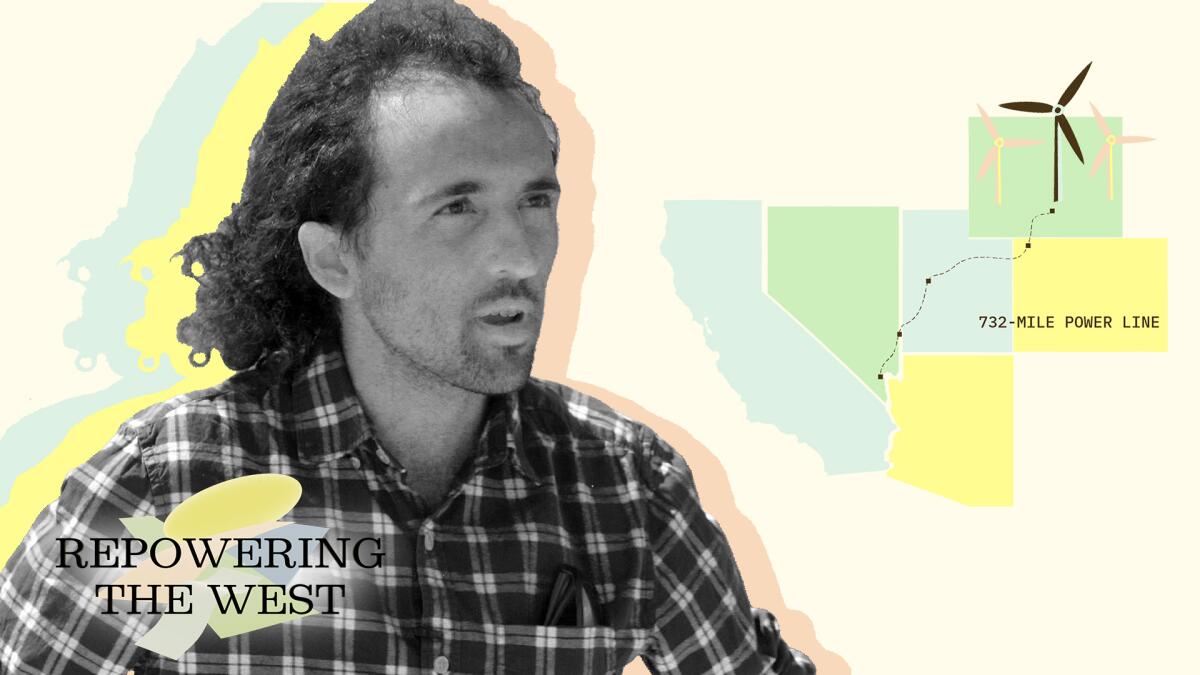
If you haven’t had a chance yet, I’d love for you to read my recent story on America’s biggest wind farm, and the power line that could forever change the American West. It was super exciting for me to see The Times devote an entire print newspaper section to the piece. I also enjoyed discussing my road trip with Gustavo Arellano on our daily news podcast, “The Times.”
If you read the story, do send me an email and let me know what you think! And as always, please consider supporting our journalism.
We’ll be back in your inbox next week. If you enjoyed this newsletter, or previous ones, please consider forwarding it to your friends and colleagues. For more climate and environment news, follow me on Twitter @Sammy_Roth.
Toward a more sustainable California
Get Boiling Point, our newsletter exploring climate change, energy and the environment, and become part of the conversation — and the solution.
You may occasionally receive promotional content from the Los Angeles Times.




